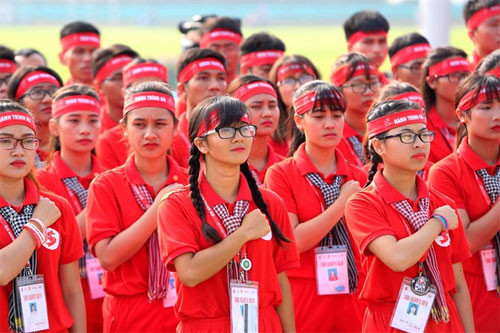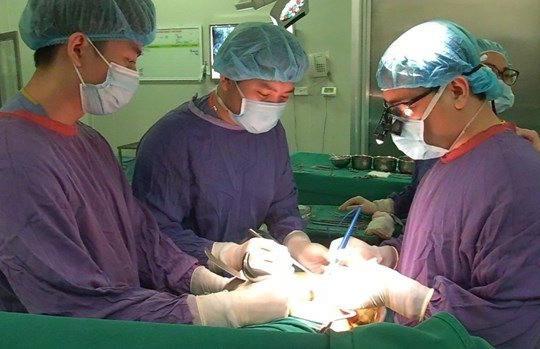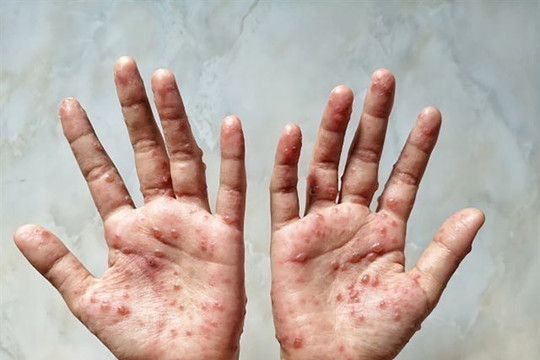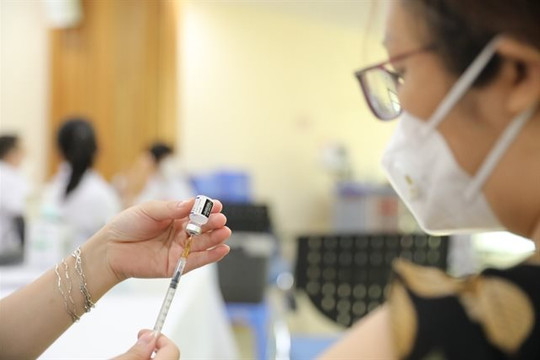 |
| Volunteers of Hanh trinh đo (Red Journey) blood-donation campaign 2017. |
With this, the total amount collected from 28 blood-donation events in the past month, held across 28 provinces and cities nationwide, have reached over 38,000 units.
“The Red Journey is an initiative of NIHBT to handle blood shortage situation in localities across the nation during the summer. Over the five years of its implementation, the journey has achieved outstanding results in making available blood sources during emergencies and for treatment in hospitals during the summer,” said Deputy Minister of Health Truong Quoc Cuong at the event.
Cuong said the campaign had successfully achieved its goals of helping provinces and cities organise blood donation festivals and communication drives, as well as to handle the huge amount of blood collected.
“In 2017, more than 16,000 blood units collected from Can Tho City, Lam Dong, Đak Lak, Tuyen Quang provinces were sent to the NIHBT in Hà Nội to ease the blood shortage situation in 170 hospitals in the 27 northern provinces,” said Cuong.
“It means that patients in the mountainous provinces of Dong Van or Ha Giang also received similar qualified blood units as patients in Ha Noi,” said Cuong.
Cuong also praised the contributions of thousands of health workers and volunteers nationwide, especially the 140 outstanding volunteers who travelled across the country to collect blood and encourage people to donate them.
“I can say that the journey has given us the expected results. It has changed the people’s mindset and the community’s awareness about voluntary blood donation,” added Cuong.
Permanent member of the National Assembly’s Social Affairs Committee Luu Binh Nhuong also attended the event to donate his blood.
“This is my fourth time. Donating blood is not only the responsibility of each resident, but also of the whole community for the sake of people’s healthcare and protection,” said Nhuong.
“I think that everybody, including policy makers or managers, should get involved in the voluntary blood donation movement,” said Nhuong.
Nguyen Thi Nguyet, a mother from Thach That District, Ha Noi, was present along with her two-year-old son at the event to donate her blood. Nguyet said she had donated blood six times, while her husband had donated blood 14 times.
Both Nguyệt and her husband, have the same sense of purpose, which is to save lives.
“I am happy to donate to save the lives of needy patients. I will continue to donate my blood in the future,” said Nguyệt.
During the one-month campaign, 140 outstanding volunteers, divided into two groups, travelled through 28 provinces and cities nationwide to collect blood and spread the message about the importance of donating blood.
They also called upon the public to donate blood in a bid to ease the current blood shortage at hospitals and raise community awareness about thalassemia — a genetic blood disorder that can lead to heart failure and liver problems.
Since the first Red Journey in 2013, thousands of patients’ lives have been saved thanks to the nearly 120,000 blood units collected in the past five years. The campaign has contributed to easing blood shortage during the summer when voluntary donors, mainly students, go home for the summer vacation, according to NIHBT.
NIHBT director Nguyen Anh Trí said that Red Journey was seen as a most unique, outstanding and effective model of voluntary blood donation mobilisation movement in Viet Nam over the past years.
In 2016, the health sector collected 1.4 million units of blood, 90 per cent of which came from voluntary donors, while only 10 per cent was collected from people who sold their blood for money
The health sector has set a goal to collect at least 1.7 million units of blood in 2017. — VNS




















.jpg)





.jpeg)

.jpeg)


.jpeg)


